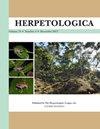Specific Habitat Elements (Refuges and Leaf Litter) Are Better Predictors of Sceloporus Lizards in Central Mexico Than General Human Disturbance
IF 1.3
3区 生物学
Q2 ZOOLOGY
引用次数: 0
Abstract
Abstract: Human land transformation alters features of the landscape that may favor or eliminate biodiversity. Understanding habitat use among species in human-affected ecosystems can inform the management of habitats and conservation of species. The Trans-Mexican Volcanic Belt in central Mexico is a biological hot spot for lizard species diversity that is under considerable anthropogenic pressures including grazing, agriculture, urbanization, and climate change. Here, we used species-occupancy modeling to (1) identify habitat characteristics that are essential to predicting the presence of Sceloporus torquatus and S. grammicus lizards, (2) determine if disturbance predicts species occupancy, and (3) determine which features, if any, predict our ability to detect each species in the wild. We found that S. torquatus lizards were more likely to be present in areas with large boulders and abundant refuges, whereas S. grammicus lizards were more common in forests with leaf litter. Human disturbance and urban disruption did not predict the occupancy of either species, with lizards making use of artificial as well as natural refuges in human settlements as well as protected areas. Although we found only weak evidence that habitat and climate predicted detection probabilities, Sceloporus lizards (particularly S. grammicus) were somewhat more easily detected in high humidity, perhaps because of generally higher activity levels. Our results emphasize the importance of understanding the detailed physical characteristics that allow each species to persist, even in disturbed habitats. This can better inform conservation efforts so that resources are allocated to ensure that these characteristics, like rocks and trees, are readily available in both pristine and human-modified areas.特定的栖息地元素(避难所和落叶层)比一般的人类干扰更能预测墨西哥中部的棘孔蜥蜴
摘要:人类对土地的改造改变了景观的特征,可能有利于或消除生物多样性。了解受人类影响的生态系统中物种之间的栖息地使用情况,可以为栖息地管理和物种保护提供信息。墨西哥中部的跨墨西哥火山带是蜥蜴物种多样性的生物热点,面临着相当大的人为压力,包括放牧、农业、城市化和气候变化。在这里,我们使用物种占有模型来(1)确定对预测斑尾蜥和克氏蜥的存在至关重要的栖息地特征,(2)确定干扰是否预测物种占有,以及(3)确定哪些特征(如果有的话)预测我们在野外检测每种物种的能力。我们发现,龙卷风蜥更有可能出现在有大石头和大量避难所的地区,而克氏蜥蜴在有落叶的森林中更常见。人类的干扰和城市的破坏并不能预测这两个物种的占有率,蜥蜴利用人类住区和保护区的人工和自然避难所。尽管我们只发现了微弱的证据表明栖息地和气候可以预测检测概率,但在高湿度条件下,Sceloporus蜥蜴(尤其是S.grammicus)更容易被检测到,可能是因为它们的活动水平普遍较高。我们的研究结果强调了了解详细的物理特征的重要性,这些特征使每个物种即使在受干扰的栖息地也能生存下来。这可以更好地为保护工作提供信息,以便分配资源,以确保这些特征,如岩石和树木,在原始和人类改造的地区都可以随时获得。
本文章由计算机程序翻译,如有差异,请以英文原文为准。
求助全文
约1分钟内获得全文
求助全文
来源期刊

Herpetologica
生物-动物学
CiteScore
4.60
自引率
0.00%
发文量
27
审稿时长
>12 weeks
期刊介绍:
Established in 1936, Herpetologica is a quarterly peer-reviewed journal serving herpetologists, biologists, ecologists, conservationists, researchers and the scientific community. The journal contains original research papers and essays about the biology of reptiles and amphibians, and covers many relevant topics including: behavior, conservation, ecology, genetics, morphology, physiology and taxonomy.
 求助内容:
求助内容: 应助结果提醒方式:
应助结果提醒方式:


